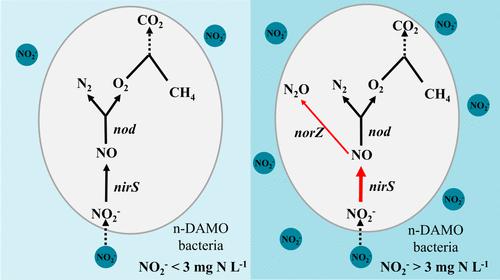当前位置:
X-MOL 学术
›
Environ. Sci. Technol.
›
论文详情
Our official English website, www.x-mol.net, welcomes your
feedback! (Note: you will need to create a separate account there.)
Evidence for Nitrous Oxide Emissions by Nitrite-Dependent Anaerobic Methane Oxidizing Bacteria
Environmental Science & Technology ( IF 10.8 ) Pub Date : 2023-10-24 , DOI: 10.1021/acs.est.3c02805 Xin Tan 1 , Yang Lu 2 , Wen-Bo Nie 3 , Guo-Jun Xie 1 , Paul Evans 2 , Xiao-Wei Wang 1 , Cheng-Cheng Dang 1 , Zhi-Cheng Zhao 1 , Sheng-Qiang Fan 1 , Nanqi Ren 1
Environmental Science & Technology ( IF 10.8 ) Pub Date : 2023-10-24 , DOI: 10.1021/acs.est.3c02805 Xin Tan 1 , Yang Lu 2 , Wen-Bo Nie 3 , Guo-Jun Xie 1 , Paul Evans 2 , Xiao-Wei Wang 1 , Cheng-Cheng Dang 1 , Zhi-Cheng Zhao 1 , Sheng-Qiang Fan 1 , Nanqi Ren 1
Affiliation

|
Nitrite-dependent anaerobic methane oxidizing (n-DAMO) bacteria generally convert nitrite to dinitrogen and bypass the nitrous oxide (N2O) formation step. However, N2O is often detected in n-DAMO bacteria dominated cultures and it remains an open question as to the microbial origin of N2O in these enrichments. Using a stable nitrite consuming microbial community enriched for n-DAMO bacteria, we demonstrated that N2O production was coupled to methane oxidation and the higher initial nitrite concentrations led to increased quantities of N2O being formed. Moreover, continuous exposure of the enrichment culture to about 5 mg of N L–1 nitrite resulted in constant N2O being produced (12.5% of nitrite was reduced to N2O). Metatranscriptomic analyses revealed that nitrite reductase (nirS) and nitric oxide reductase (norZ) transcripts from n-DAMO bacteria increased in response to nitrite exposure. No other bacteria significantly expressed nor genes under these conditions, suggesting n-DAMO bacteria are responsible for N2O being produced. In a 35-day bioreactor experiment, N2O produced by the n-DAMO bacteria accumulated when nitrite was in excess; this was found to be up to 3.2% of the nitrogen that resulted from nitrite removal. Together, these results suggested that excess nitrite is an important driver of N2O production by n-DAMO bacteria. To this end, proper monitoring and control of nitrite levels in wastewater treatment plants would be effective strategies for mitigating N2O emissions to the atmosphere.
中文翻译:

亚硝酸盐依赖性厌氧甲烷氧化细菌排放一氧化二氮的证据
亚硝酸盐依赖性厌氧甲烷氧化 (n-DAMO) 细菌通常将亚硝酸盐转化为二氮并绕过一氧化二氮 (N 2 O) 形成步骤。然而,N 2 O 经常在 n-DAMO 细菌为主的培养物中检测到,并且关于这些富集中 N 2 O的微生物起源仍然是一个悬而未决的问题。使用富含 n-DAMO 细菌的稳定的亚硝酸盐消耗微生物群落,我们证明了 N 2 O 的产生与甲烷氧化有关,并且较高的初始亚硝酸盐浓度导致形成的 N 2 O 数量增加。此外,将富集培养物连续暴露于约5 mg NL –1亚硝酸盐会导致不断产生N 2 O(12.5% 的亚硝酸盐被还原为N 2 O)。宏转录组学分析表明,n-DAMO 细菌的亚硝酸还原酶 ( nirS ) 和一氧化氮还原酶 ( norZ ) 转录物随着亚硝酸盐暴露而增加。在这些条件下,没有其他细菌或基因显着表达,这表明 n-DAMO 细菌负责产生N 2 O。在为期35天的生物反应器实验中,当亚硝酸盐过量时,n-DAMO细菌产生的N 2 O积累;结果发现,这一比例高达亚硝酸盐去除产生的氮的 3.2%。总之,这些结果表明过量的亚硝酸盐是n-DAMO 细菌产生N 2 O 的重要驱动因素。为此,适当监测和控制废水处理厂中的亚硝酸盐水平将是减少向大气中排放N 2 O 的有效策略。
更新日期:2023-10-24
中文翻译:

亚硝酸盐依赖性厌氧甲烷氧化细菌排放一氧化二氮的证据
亚硝酸盐依赖性厌氧甲烷氧化 (n-DAMO) 细菌通常将亚硝酸盐转化为二氮并绕过一氧化二氮 (N 2 O) 形成步骤。然而,N 2 O 经常在 n-DAMO 细菌为主的培养物中检测到,并且关于这些富集中 N 2 O的微生物起源仍然是一个悬而未决的问题。使用富含 n-DAMO 细菌的稳定的亚硝酸盐消耗微生物群落,我们证明了 N 2 O 的产生与甲烷氧化有关,并且较高的初始亚硝酸盐浓度导致形成的 N 2 O 数量增加。此外,将富集培养物连续暴露于约5 mg NL –1亚硝酸盐会导致不断产生N 2 O(12.5% 的亚硝酸盐被还原为N 2 O)。宏转录组学分析表明,n-DAMO 细菌的亚硝酸还原酶 ( nirS ) 和一氧化氮还原酶 ( norZ ) 转录物随着亚硝酸盐暴露而增加。在这些条件下,没有其他细菌或基因显着表达,这表明 n-DAMO 细菌负责产生N 2 O。在为期35天的生物反应器实验中,当亚硝酸盐过量时,n-DAMO细菌产生的N 2 O积累;结果发现,这一比例高达亚硝酸盐去除产生的氮的 3.2%。总之,这些结果表明过量的亚硝酸盐是n-DAMO 细菌产生N 2 O 的重要驱动因素。为此,适当监测和控制废水处理厂中的亚硝酸盐水平将是减少向大气中排放N 2 O 的有效策略。













































 京公网安备 11010802027423号
京公网安备 11010802027423号